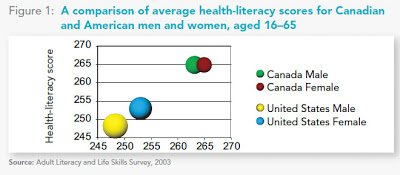One of the issues raised at the recent DTC National conference in Washington, DC was the impact of direct-to-consumer (DTC) advertising on health literacy.
Mark Senak — blogger at EyeOnFDA, who participated in a panel discussion — raised the ante on DTC’s educational merit and suggested that we “Look abroad (where there is no DTC), and measure the health literacy to see the potential impact” (see these tweets).
I did some research and found a report that compared health literacy in the US (where there IS DTC) and in Canada (where there is no DTC advertising). The report, entitled “Health Literacy in Canada,” cited research that used the same point system as the US to measure health literacy in Canada and compared it’s results to the US data:
“Canadian men outperform their American counterparts by roughly 12 points. Canadian women outperform their American peers by roughly 15 points. These differences are larger than the differences in the underlying cognitive skills such as literacy and numeracy, which raises questions about the underlying causes of the differences and their impact on population health.”
 This was summed up in the chart on the left.
This was summed up in the chart on the left.
So much for DTC improving health literacy!
Proponents of DTC advertising often defend it by saying that it is educational. Does this data destroy that argument?
Not necessarily. There is a difference between health literacy and being “educated” about a drug. DTC proponents may need to place an asterik next to “education” in their argument about the utility of DTC so we all understand that they mean the latter and not the former.








![6 Digital Tools at the Center of Healthcare Digitalization [INFOGRAPHIC]](http://ec2-54-175-84-28.compute-1.amazonaws.com/pharma-mkting.com/wp-content/uploads/2021/04/6DigitalTools_600px-100x70.jpg)




